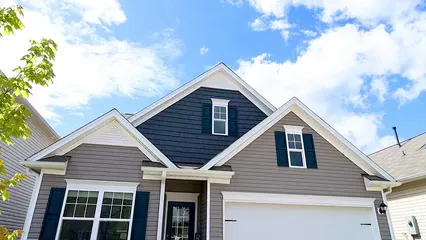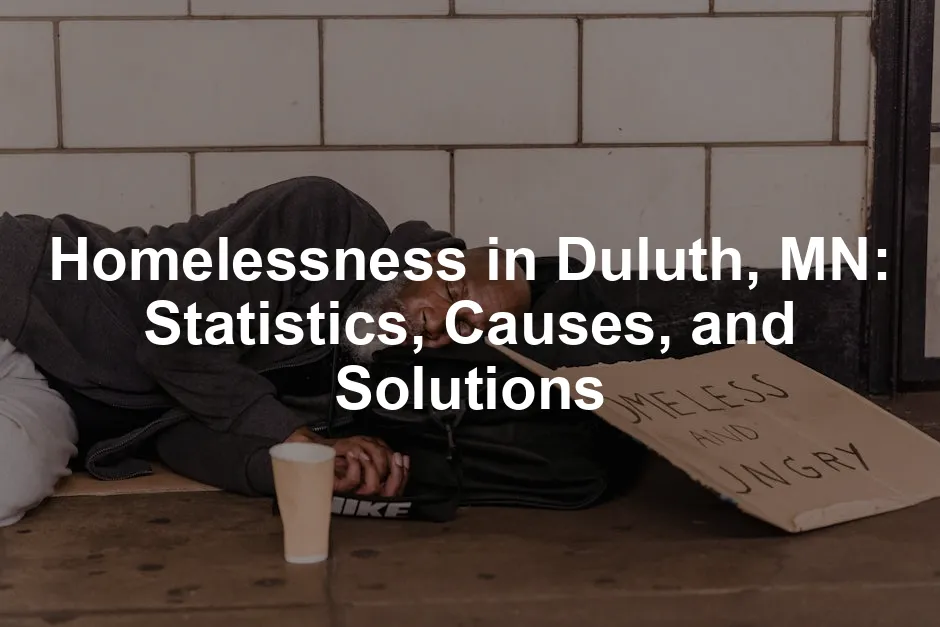Introduction
Duluth, Minnesota, faces a significant homelessness crisis. With its stunning views of Lake Superior, one might not expect such a pressing social issue. However, the reality is stark: many individuals and families struggle to find stable housing. Understanding the statistics surrounding homelessness in Duluth is essential for addressing this complex issue effectively. The recent Point in Time count revealed that 606 individuals were experiencing homelessness in Duluth. This number illustrates a troubling trend in the city. Over the past five years, homelessness has been on the rise, reflecting broader economic challenges and societal shifts. The COVID-19 pandemic has exacerbated these issues, increasing the number of people without homes further. As many lost jobs or faced financial hardships, the gap between those with stable housing and those without has widened. Understanding local statistics and demographics is vital to implementing effective solutions. It enables policymakers, nonprofits, and community members to direct resources where they’re needed most. Moreover, it helps foster awareness and encourage community engagement in addressing homelessness. The need for collaborative efforts has never been more crucial as Duluth seeks to navigate its way through this crisis. If you’re looking to dive deeper into the topic of homelessness, consider picking up “Homelessness: A Crisis in America”. This book provides a comprehensive overview of the issue, shedding light on the complexities and challenges that many face. In the following sections, we’ll dive into the current statistics on homelessness in Duluth, exploring the demographics of the homeless population and the types of homelessness present in the community. By unpacking these statistics, we can better understand the landscape of homelessness in Duluth and work towards viable solutions.
Current Statistics on Homelessness in Duluth
Overview of Statistics
The 2022 Point in Time count in Duluth highlighted a concerning reality: 606 individuals were reported as experiencing homelessness. This figure represents a notable increase from previous years, reflecting a 20% rise in homelessness over the past five years. In St. Louis County, the situation is even more troubling, with an estimated 6,000 individuals experiencing homelessness. This staggering number underscores the urgent need for comprehensive solutions tailored to the unique challenges faced by the community. Factors contributing to this increase include a shortage of affordable housing options, rising rental costs, and systemic issues related to mental health and substance abuse. The difficulties faced by many individuals seeking housing are compounded by the lack of adequate support services. As the population of Duluth continues to grow, the demand for affordable housing has outstripped supply, leaving many vulnerable residents without stable housing. To better equip oneself for the journey of understanding and supporting those experiencing homelessness, consider the insightful read “Evicted: Poverty and Profit in the American City”. This book dives into the complexities of eviction and its impact on the lives of those affected.Demographics of the Homeless Population
To fully understand homelessness in Duluth, it’s critical to examine the demographics of the homeless population. Nearly 40% of those experiencing homelessness in Duluth are Black or Native American. This disproportionate representation highlights the intersection of race and socioeconomic status in the homelessness crisis. Moreover, youth homelessness is a significant concern, with over 6,000 unaccompanied youth experiencing homelessness statewide. Many of these young individuals face challenges stemming from trauma, violence, and systemic barriers. It’s essential for community organizations to recognize these demographics when designing programs and interventions. By tailoring services to meet the specific needs of diverse groups, Duluth can make strides toward alleviating homelessness and ensuring that all residents have access to safe and stable housing. If you’re interested in learning more about the psychological impacts of trauma that many homeless individuals face, check out “The Body Keeps the Score: Brain, Mind, and Body in the Healing of Trauma”. This book is a vital resource for understanding trauma’s long-lasting effects and how it can influence one’s life. As we move forward in this discussion, it’s crucial to keep these statistics in mind. They provide a foundation for understanding the complexities of homelessness in Duluth and underscore the importance of targeted efforts to address this growing crisis.
Types of Homelessness
Homelessness isn’t a one-size-fits-all situation. In Duluth, it can be broadly categorized into two main types: sheltered and unsheltered. The 2022 Point in Time count revealed a staggering 606 individuals experiencing homelessness in Duluth, with 234 of those individuals classified as unsheltered. Unsheltered homelessness refers to those without any fixed, regular, and adequate nighttime residence. These individuals may be living in parks, cars, or other places not meant for human habitation. On the other hand, sheltered homelessness includes those residing in temporary accommodations, such as emergency shelters or transitional housing. This distinction is crucial because it helps local organizations tailor their resources and support accordingly. For those unsheltered, immediate needs may include food, safety, and basic hygiene services, while sheltered individuals might require assistance with finding permanent housing solutions. If you’re looking to support those in need while also being prepared for emergencies, consider an Emergency Survival Kit. This kit is a great way to ensure that you have the essentials in case of unforeseen circumstances. Further classification of homelessness reveals three primary categories: chronic, temporary, and family units. Chronic homelessness affects individuals who have experienced repeated or prolonged episodes of homelessness, often compounded by health or mental health issues. Temporary homelessness, however, involves individuals or families facing short-term crises, like job loss or eviction, leading to a brief period without housing. Family units experiencing homelessness often face unique challenges, such as maintaining stability for children while seeking housing. Understanding these categories is vital for developing effective strategies to address homelessness in Duluth. Each type requires a different approach, and providing targeted support can significantly improve outcomes for those affected.
Causes of Homelessness in Duluth
Economic Factors
Duluth’s economy has undergone significant shifts, impacting its residents in various ways. The transition from stable manufacturing jobs to lower-paying roles in the tourism sector has left many individuals struggling to make ends meet. Job loss and rising rental costs are two primary economic factors contributing to homelessness. As the cost of living climbs, families and individuals face tough choices between food, healthcare, and housing. This precarious balance often tips, resulting in eviction and homelessness. Additionally, the recent economic downturns exacerbated by the COVID-19 pandemic have left many without jobs, pushing them into homelessness. With unemployment rates fluctuating dramatically, the need for sustainable job opportunities and affordable housing has never been more critical. If you’re keen on understanding the psychology behind habits and their impact on life choices, then “The Power of Habit: Why We Do What We Do in Life and Business” is a fantastic read. Understanding habits can help you navigate life’s challenges more effectively.Mental Health and Substance Abuse
Mental health issues are frequently intertwined with homelessness, creating a complex web of challenges. Many individuals experiencing homelessness also struggle with mental health disorders, which can hinder their ability to secure stable housing. The Minnesota Drug Overdose and Substance Use Surveillance Activity (MNDOSA) report highlights alarming rates of substance misuse among the homeless population, indicating a significant need for mental health support and addiction services. The stigma surrounding mental health and substance abuse often prevents individuals from seeking help. Many feel isolated, battling their struggles alone, which can lead to a cycle of homelessness. Addressing these issues requires a holistic approach, focusing not only on housing but also on providing mental health services, addiction treatment, and community support. For those looking to create a calming environment for mental health support, consider using an Essential Oil Diffuser. Aromatherapy can significantly improve mood and create a soothing atmosphere for those in distress. By understanding these causes, Duluth can effectively mobilize resources to tackle the homelessness crisis head-on, ensuring that individuals receive the help they need to regain stability in their lives.
Housing Availability
Duluth’s housing scene is a bit of a rollercoaster, and not the fun kind. The city faces a pressing shortage of affordable housing options. High rents have pushed many residents to the brink. It’s as if the landlords have convened a secret meeting and decided to raise prices just for kicks. Many individuals and families struggling with homelessness find themselves in a bind, unable to secure stable housing. In response, city planners have unveiled ambitious plans for new housing developments. These projects are crucial for addressing homelessness. The construction of affordable units is not just a dream; it’s a pressing necessity. Recent groundbreaking ceremonies for affordable housing complexes are a sign of hope. These developments aim to provide safe and stable homes for those who need it most. After all, a roof over your head shouldn’t be a luxury; it should be a right. If you’re a cooking enthusiast looking to prepare affordable meals, consider getting an Instant Pot Duo 7-in-1. It’s a fantastic tool that can help you whip up delicious meals while saving time and money.Community and Historical Context
Duluth has become a magnet for the homeless population in the region. Why? Many individuals from surrounding areas flock to the city seeking better opportunities and services. Unfortunately, the reality is that they often end up homeless, facing challenges that seem insurmountable. It’s a tragic irony that those looking for help sometimes find themselves in more precarious situations. Historically, Duluth has weathered economic storms, transitioning from a bustling port city to one grappling with significant economic challenges. The decline of manufacturing jobs left many residents without stable employment. Add to that the rising rental costs, and you have a recipe for disaster. The intersection of these historical factors and current economic conditions has contributed to a growing homelessness crisis. As the city continues to evolve, understanding this context is essential for crafting effective solutions to support those in need.
The Stepping On Up Initiative
Duluth has launched the “Stepping On Up” initiative, a five-year plan focused on tackling homelessness head-on. This ambitious strategy is a collaborative effort involving ten agencies aimed at reforming the city’s homeless response system. The plan consists of three distinct phases. The first phase introduces outdoor villages, providing authorized safe spaces for individuals living in tents or vehicles. These sites will be equipped with sanitation facilities and social services support, allowing for a dignified transition for residents. Phase two aims to create indoor villages with 100 new emergency shelter beds. This will offer individuals a safe, secure environment with access to support staff and communal spaces. The ultimate goal is to stabilize individuals before moving them into permanent housing. Finally, phase three will address the critical shortage of affordable housing. Through new construction and creative solutions like converting non-residential buildings, Duluth hopes to provide long-term housing options. By implementing these phases, the initiative seeks to create a sustainable and supportive environment for those in need.
Community Involvement
Community volunteers and local businesses play a crucial role in supporting homelessness initiatives in Duluth. Their efforts help create a safety net for vulnerable populations. Volunteers assist in shelters, food banks, and outreach programs, providing essential support to those facing homelessness. Local businesses are also stepping up, offering resources and sponsorships for community events aimed at raising awareness about homelessness. This partnership fosters a sense of responsibility within the community, encouraging residents to advocate for systemic change. Public awareness and advocacy are vital in combating homelessness. By spreading the word about local initiatives, residents can engage with their community, share stories, and push for policy changes. Together, they can help create a more inclusive and empathetic environment for everyone, ensuring that the voices of those affected by homelessness are heard and prioritized.
The Impact of COVID-19 on Homelessness
The COVID-19 pandemic has had a profound impact on homelessness in Duluth, exacerbating existing issues and creating new challenges. With job losses and financial instability on the rise, many individuals found themselves without a safe place to call home. The pandemic’s ripple effects have driven up the number of people experiencing homelessness, as eviction moratoriums lifted and economic uncertainties lingered. Service delivery also changed dramatically during the pandemic. Many traditional shelters faced capacity limits due to health guidelines, forcing individuals to seek shelter in less safe conditions or outdoors. Local organizations quickly adapted, offering innovative solutions like outdoor safe spaces and enhanced outreach efforts to reach those in need. Community responses included increased collaboration between organizations and local government, ensuring that essential services could continue. Emergency funding was allocated to support food distribution, healthcare access, and mental health services, recognizing that these are critical for those experiencing homelessness. Moreover, the pandemic highlighted the importance of public health measures. Individuals experiencing homelessness are more susceptible to health risks, making it crucial to provide adequate resources and support. Vaccination clinics were established in shelters and outreach sites, ensuring that this vulnerable population had access to vital health services. The pandemic underscored the need for long-term solutions to homelessness. While temporary measures have provided relief, addressing the root causes of homelessness remains essential. The community’s resilience and adaptability during these challenging times have laid the groundwork for future initiatives aimed at combating homelessness in Duluth. With continued collaboration, public awareness, and advocacy, there is hope for a more sustainable future for all residents, ensuring that everyone has a place to call home.
Conclusion
Homelessness in Duluth, MN, is a pressing issue that has seen a significant rise in recent years. With over 600 individuals reported experiencing homelessness in the city, the statistics are alarming. This situation is compounded by a lack of affordable housing and rising living costs, leaving many residents vulnerable. The demographics reveal a concerning disparity, with nearly 40% of the homeless population being Black or Native American. Understanding these statistics is crucial for addressing the underlying issues that contribute to homelessness. Throughout this article, we explored the various causes of homelessness, from economic factors to mental health challenges. Each factor plays a part in the complex web of homelessness, requiring a multifaceted approach to create lasting solutions. Duluth’s community response, including initiatives like the “Stepping On Up” plan, aims to tackle these challenges head-on. This plan focuses on creating outdoor villages, improving shelter capacity, and increasing affordable housing options. It’s a collaborative effort that seeks to create a robust support system for those in need. Community engagement and policy advocacy are paramount in this fight. Residents, businesses, and local organizations must work together to ensure that resources are directed where they are most needed. By supporting initiatives aimed at reducing homelessness, individuals can contribute to positive change. Whether through volunteering, donating, or simply spreading awareness, every effort counts. As we move forward, let’s remember that homelessness is not just a statistic; it’s a human issue. Each person experiencing homelessness has a story, a background, and a desire for a better future. Together, we can foster a community that supports all its members, ensuring that everyone has a place to call home. It’s time to take action—join local initiatives, support your community, and help reduce homelessness in Duluth.
FAQs
What are the current statistics on homelessness in Duluth?
According to the 2022 Point in Time count, there are approximately 606 individuals experiencing homelessness in Duluth. This figure represents a worrying trend, with a 20% increase in homelessness over the past five years. In St. Louis County, the number escalates to over 6,000 individuals, highlighting the urgent need for effective solutions.
How can I help the homeless community in Duluth?
There are several ways to assist the homeless community in Duluth: Volunteer: Join local organizations like CHUM or the Damiano Center to provide support in shelters and food banks.Donate: Contribute items such as clothing, hygiene products, or non-perishable food to local shelters.Advocate: Support local initiatives and policies that aim to reduce homelessness by engaging with your local government.
What are the main causes of homelessness in Duluth?
Several factors contribute to homelessness in Duluth, including: Economic Challenges: Job losses and rising rental costs have made housing unaffordable for many residents.Mental Health and Substance Abuse: A significant proportion of the homeless population struggles with mental health issues or substance misuse.Lack of Affordable Housing: The scarcity of affordable housing options leaves vulnerable populations without stable living arrangements.
Are there specific organizations working to address homelessness in Duluth?
Yes, several organizations are dedicated to tackling homelessness in Duluth, including: CHUM: Provides emergency shelter, food, and outreach services.The Damiano Center: Offers meals, shelter, and support services for those experiencing homelessness.Life House: Focuses on youth homelessness, providing housing and support services for young individuals.
What is the Stepping On Up initiative?
The Stepping On Up initiative is a five-year plan aimed at reforming Duluth’s approach to homelessness. This collaborative effort involves multiple agencies working together to create outdoor villages, increase shelter capacity, and develop affordable housing solutions. The initiative emphasizes community involvement and aims to provide sustainable support for those experiencing homelessness.
If you’re a fan of feel-good stories that tackle social issues, don’t miss out on the inspiring movie “A Beautiful Day in the Neighborhood”. It beautifully illustrates the importance of kindness and understanding, something we can all aspire to incorporate into our lives. Please let us know what you think about our content by leaving a comment down below! Thank you for reading till here 🙂For more insights on the current state of homelessness and statistics in Duluth, check out our detailed analysis on homelessness in Duluth.
All images from Pexels




